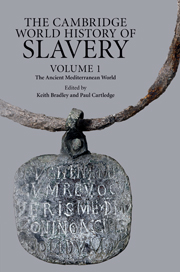Book contents
- Frontmatter
- Contents
- Series editors' introduction
- List of figures
- Acknowledgements
- Introduction
- 1 Slavery in the ancient Near East
- 2 Slaves in Greek literary culture
- 3 Classical Athens
- 4 The Helots: a contemporary review
- 5 Slavery and economy in the Greek world
- 6 The slave supply in classical Greece
- 7 Slavery and the Greek family
- 8 Resistance among chattel slaves in the classical Greek world
- 9 Archaeology and Greek slavery
- 10 Slavery in the Hellenistic world
- 11 Slavery and Roman literary culture
- 12 Slavery in the Roman Republic
- 13 Slavery Under the Principate
- 14 The Roman slave supply
- 15 Slave labour and Roman society
- 16 Slavery and the Roman family
- 17 Resisting slavery at Rome
- 18 Slavery and Roman material culture
- 19 Slavery and Roman law
- 20 Slavery and the Jews
- 21 Slavery and the rise of Christianity
- 22 Slavery in the late Roman world
- Bibliography
- General index
- Index of ancient passages cited
- Index of inscriptions and papyri
- Index of Jewish and Christian Literature Cited
6 - The slave supply in classical Greece
Published online by Cambridge University Press: 28 September 2011
- Frontmatter
- Contents
- Series editors' introduction
- List of figures
- Acknowledgements
- Introduction
- 1 Slavery in the ancient Near East
- 2 Slaves in Greek literary culture
- 3 Classical Athens
- 4 The Helots: a contemporary review
- 5 Slavery and economy in the Greek world
- 6 The slave supply in classical Greece
- 7 Slavery and the Greek family
- 8 Resistance among chattel slaves in the classical Greek world
- 9 Archaeology and Greek slavery
- 10 Slavery in the Hellenistic world
- 11 Slavery and Roman literary culture
- 12 Slavery in the Roman Republic
- 13 Slavery Under the Principate
- 14 The Roman slave supply
- 15 Slave labour and Roman society
- 16 Slavery and the Roman family
- 17 Resisting slavery at Rome
- 18 Slavery and Roman material culture
- 19 Slavery and Roman law
- 20 Slavery and the Jews
- 21 Slavery and the rise of Christianity
- 22 Slavery in the late Roman world
- Bibliography
- General index
- Index of ancient passages cited
- Index of inscriptions and papyri
- Index of Jewish and Christian Literature Cited
Summary
APPROACHING THE GREEK SLAVE SUPPLY
How did Greeks obtain their slaves, and how did men, women and children come to be slaves in classical Greece? While statistics are elusive, no one would seriously challenge the fact that there were large numbers of slaves in the Greek world of various kinds and origins. This chapter seeks to explore the processes that brought people into slavery in Greece, and also to give some sense of the individual slave's experience of these processes. The sheer scale of enslavement meant that the supply of slaves was a central feature of the ancient economy, quite apart from its fundamental social significance within and beyond Greek culture. The slave trade was everywhere. At the periphery of Greek culture, slaves were traded all around the Black Sea, in the Adriatic and in the Eastern Mediterranean and North Africa. So too at its traditional centres – in Athens, Aegina, Corinth, Chios and elsewhere. The scattered instances about which our sources tell us are no more than drops in the great ocean of the ancient Greek slave trade, with its ripples reaching far and wide into ‘barbarian’ hinterlands.
The slave trade was also everywhere in ideological terms, explored by philosophers or expressed in art, from Homer through Athenian tragedy and historical and geographical writing of all kinds. Moreover, the slave trade was treated as a fit topic even for comedy, whether in satirical poetry or on the stage.
- Type
- Chapter
- Information
- The Cambridge World History of Slavery , pp. 112 - 133Publisher: Cambridge University PressPrint publication year: 2011
- 9
- Cited by



